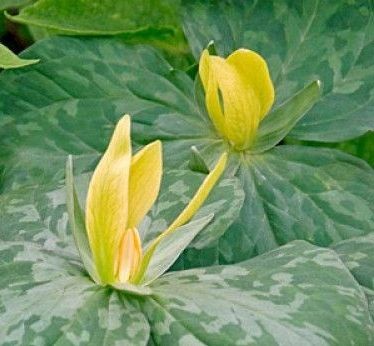Mottled wakerobin
(Trillium discolor)

Description
Trillium discolor, the mottled wakerobin, pale yellow trillium, or small yellow toadshade, is a species of flowering plant in the family Melanthiaceae. It is native to areas of the Savannah River drainage system of Georgia, North Carolina and South Carolina such as Steven's Creek Heritage Preserve and Lake Keowee. It is found along moist stream banks in upland woods, on acidic to basic soils. Trillium discolor is a perennial herbaceous plant that blooms mid April to early May. It has a flower with pale yellow petals that stand upright at the junction of the three leaf-like bracts. Trillium (trillium, wakerobin, toadshade, tri flower, birthroot, birthwort, and sometimes "wood lily") is a genus of about fifty flowering plant species in the family Melanthiaceae. Trillium species are native to temperate regions of North America and Asia, with the greatest diversity of species found in the southern Appalachian Mountains in the southeastern United States. Plants of this genus are perennial herbs growing from rhizomes. There are three large leaf-like bracts arranged in a whorl about a scape that rises directly from the rhizome. There are no true aboveground leaves but sometimes there are scale-like leaves on the underground rhizome. The bracts are photosynthetic and are sometimes called leaves. The inflorescence is a single flower with three green or reddish sepals and three petals in shades of red, purple, pink, white, yellow, or green. At the center of the flower there are six stamens and three stigmas borne on a very short style, if any. The fruit is fleshy and capsule-like or berrylike. The seeds have large, oily elaiosomes. Occasionally individuals have four-fold symmetry, with four bracts (leaves), four sepals, and four petals in the blossom. The tetramerous condition has been described for several species of Trillium including T. chloropetalum, T. erectum, T. grandiflorum, T. maculatum, T. sessile, and T. undulatum. In 1753, Swedish botanist Carl Linnaeus established the genus Trillium by recognizing three species, Trillium cernuum, Trillium erectum, and Trillium sessile. The type specimen Trillium cernuum described by Linnaeus was actually Trillium catesbaei, an oversight that subsequently led to much confusion regarding the type species of this genus. Initially the Trillium genus was placed in the family Liliaceae.
Taxonomic tree:







